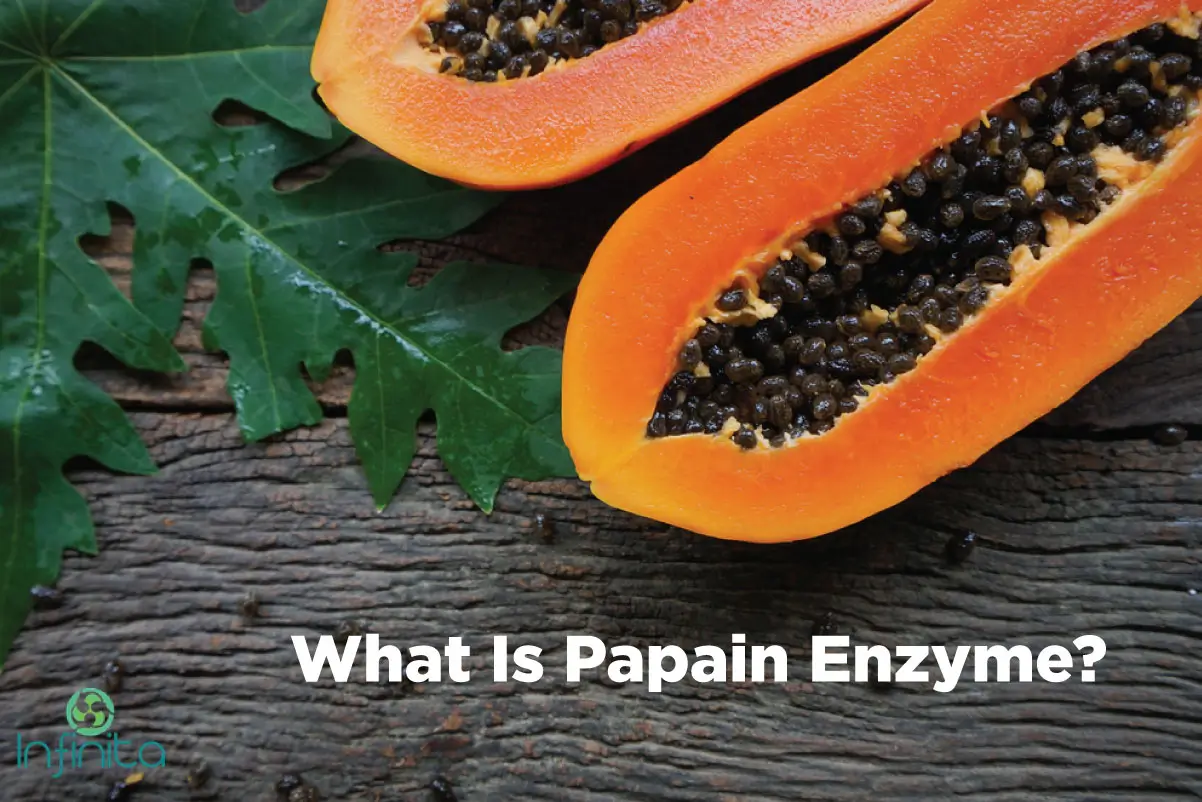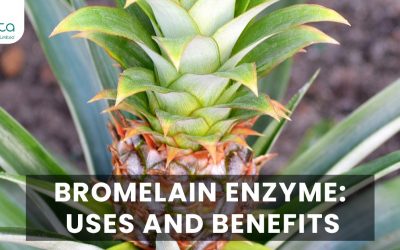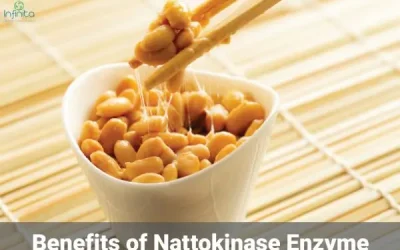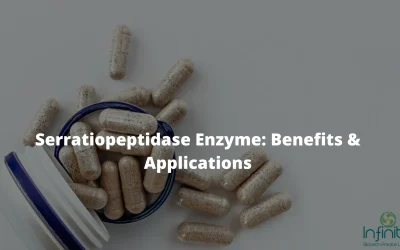Overview Of Papain Enzyme
Papain, also known as papaya proteinase I, is a cysteine protease (EC 3.4.22.2) enzyme present in papaya (Carica papaya) and mountain papaya (Vasconcellea cundinamarcensis). Papain is taken from the fruit of the papaya tree. It is used to make medicine.
Some people take papain by mouth for pain and swelling (inflammation) and to remove extra fluid following trauma and surgery. It is also taken by mouth to help with digestion, to treat parasitic worms, inflammation of the throat and pharynx, shingles (herpes zoster) symptoms, sore muscles, diarrhea, hay fever, runny nose, and a skin condition called psoriasis. Papain is also taken by mouth to treat the side effects of radiation therapy, or it may be used in combination with other therapies to treat tumors.
Some people apply papain directly to the skin to treat insect or animal bites, infected wounds, sores, and ulcers.
In manufacturing, papain is used in cosmetics, toothpaste, contact lens cleaners, meat tenderizers, and meat products.
Structure Of Papain Enzyme
The papain precursor protein contains 345 amino acid residues and consists of a signal sequence (1-18), a propeptide (19-133) and the mature peptide (134-345). The amino acid numbers are based on the mature peptide. The protein is stabilised by three disulfide bridges. Its three-dimensional structure consists of two distinct structural domains with a cleft between them. This cleft contains the active site, which contains a catalytic diad that has been likened to the catalytic triad of chymotrypsin. The catalytic triad is made up of the amino acids – cysteine-25 (from which it gets its classification) and histidine-159. Aspartate-158 was thought to play a role analogous to the role of aspartate in the serine protease catalytic triad, but that has since been disproved.
Function Of Papain Enzyme
The mechanism by which papain breaks peptide bonds involves the use of a catalytic triad with a deprotonated cysteine. Asn-175 helps to orient the imidazole ring of His-159 to allow it to deprotonate the catalytic Cys-25. This cysteine then performs a nucleophilic attack on the carbonyl carbon of a peptide backbone. This forms a covalent acyl-enzyme intermediate and frees the amino terminus of the peptide. The enzyme is deacylated by a water molecule and releases the carboxyl-terminal portion of the peptide. In immunology, papain is known to cleave the Fc (crystallisable) portion of immunoglobulins (antibodies) from the Fab (antigen-binding) portion.
Papain is a relatively heat-resistant enzyme, with an optimal temperature range of 60 and 70 °C. Papain prefers to cleave at (hydrophobic)- (Arg or Lys)- cleaves here – (not Val). Hydrophobic is Ala, Val, Leu, Ile, Phe, Trp, or Tyr.
Uses Of Papain Enzyme
Papain breaks down tough meat fibers and has been used for thousands of years to tenderise meat eaten in its native South America. Meat tenderisers in powder form with papain as an active component are widely sold.
Papain can be used to dissociate cells in the first step of cell culture preparations. A ten-minute treatment of small tissue pieces (less than 1 mm cubed) will allow papain to begin cleaving the extracellular matrix molecules holding the cells together. After ten minutes, the tissue should be treated with a protease inhibitor solution to stop the protease action. Left untreated, papain activity will lead to complete lysis of the cells. The tissue must then be triturated (passed quickly up and down through a Pasteur pipette) to break up the pieces of tissue into a single cell suspension.
It is also used as an ingredient in various enzymatic debriding preparations, notably Accuzyme. These are used in the care of some chronic wounds to clean up dead tissue.
Papain is added to some toothpaste and mint sweets as a tooth whitener. Its whitening effect is, however, minimal because the papain is present in low concentrations and is quickly diluted by saliva. It would take several months of use to have a noticeable effect.
Papain is the main ingredient of Papacarie, a gel used for chemomechanical dental caries removal. It does not require drilling and does not interfere in the bond strength of restorative materials to dentin.
Papain has been known to interfere with urine drug tests for cannabinoids. It is found in some drug detox products.
Recently, it has been demonstrated that papain can be used to assemble thin films of titania used in photovoltaic cells.
Benefits Of Papain Enzyme
1. Stimulates Digestion
One of the key areas in which papain serves the body is in the realm of its protein-digestive properties. One case study found that when a male patient with gluten intolerance ate a gluten-free diet, he still experienced diarrhea, but when he additionally took 1800 mg of papain for one month, he had fewer loose stools and less malabsorption. This is just one study, and more research needs to be conducted.
2. Aids Skin and Wound Healing
Due to papain’s beneficial capacities, people have used it for many years as a topical application to burns, ulcers, irritations, bedsores and other wounds, and to assist recovery from sports injuries. Some practitioners have used it dental cavities. Papain’s enzymatic action is very specific, and it does not harm healthy skin. Traditional cultures in Hawaii and Tahiti made poultices out of the skins of papaya, as this part of the fruit has a particularly high concentration of papain. Traditional healers applied this substance to the skin to heal wounds, burns, rashes and insect stings.
3. Digests Mucus
Studies have found that papain digests sinus mucin, a glycoprotein found in mucus, and hence may have beneficial effects for people having sinus issues. Papain makes mucus less viscous, or runnier, and hence better able to be eliminated. Because of this feature, some researchers are studying how papain can help deliver nanoparticle medicines to the body so that they can get through the body’s natural mucosal barrier in the gut. Using papain with nanoparticles may not be the best for your health.
4. Supports Immune System Function
Studies have found that papain may have anti-cell proliferation properties. Some studies have shown papain delivers a strong effect while others found no difference between papain and controls. A review article found strong evidence for the overall immune function properties of papaya.
5. Resists Redness and Irritation
Studies confirm that the papain enzyme offers powerful resistance to redness and irritation. Papain helps aid the absorption of another beneficial substance, quercetin. One study found that when papain and bromelain were given along with quercetin, it helped swelling symptoms associated with prostate health.
6. Acts as an Antioxidant
Papain holds compounds that may aid in protecting the body from cellular damage caused by free radicals, which makes it an antioxidant. The compounds in papaya juice effectively scavenge, or counteract, highly reactive hydroxyl (OH-) free radicals, as well as super-oxides. Papain has an antioxidant level on par with Vitamins E and C. In one study, the Sunrise Solo cultivar (a type of papaya) was more effective as an antioxidant than two other cultivars.
7. Prevents Food Spoilage
Since research has shown papain has antifungal and antibacterial properties, and it is sometimes used to preserve foods naturally. It is a powerful agent commonly used in food preservation, reducing bacterial infestations and spoilage due to oxidation.
How Does Papain Tenderize Meat?
The most important characteristics of meat quality are tenderness, juiciness, and flavour. Consumers consider tenderness as the most important factor in determining eating satisfaction of beef (Issanchou, 1996, Boleman, Miller, Taylor, Cross, Wheeler, Koohmaraie, Johnson and Savell, 1997). Tenderness is defined as the ease of mastication, which involves the initial ease of penetration by the teeth, the ease with which the meat breaks into fragments and the amount of residue remaining after mastication (Lawrie, 1998).
Meat tenderness depends on spices, breed, age, sex and individual skeletal muscle tissue of the animal. Tenderness originates in structural and biochemical properties of scheletal muscle fibers, especially myofibrils and intermediate filaments, and of the intramuscular connective tissue, the endomysium and perimysium, which are composed of collagen fibrils and fibers (Takahashi, 1996). The mechanical stability of collagen fibrils increased markedly with chronological aging.
Meat produced from an old animal is tough and has a lower eating quality. Improvement of meat tenderness of aged cattle is necessary to increase functional properties and value of the meat (Shiba, 2004). Meat can be tenderized in different ways: mechanical methods (mincing or hitting to crush the conjunctive and muscle tissue), chemical methods by injecting in the muscle solutions with chemical substances (salt, sodium chloride, sodium polyphosphate, potassium lactate, sodium diacetate all dissolved into water, R.K., 2003), enzymatic methods used proteolytic enzymes like papain, bromelain or ficin.
Enzymatic tenderisation can be made in a humid way (by injecting in the muscle solutions with enzymatic preparations) or in a dry way (pressing tender mixtures on the meat surface). The end of the tenderisation process and the method employed for aging and thermal processing should be established to get an optimum sensorial quality of the meat.
Injection of beef cuts with papain cause an important improvement of functional properties of adult beef. Papain is a powerful proteases preparation, with great under-layer specificity, catalysing the breaking of the peptidic bonds in the protein molecules and their degradation products to amino acids. The increase of the papain level, from injection brine, as well as the increase of the time of ageing, determined a significant weakening of the meat structure. Papain tenderisation of the adult beef determined the improvement of tenderness, flavour, and juiciness. It is recommended to use papain doses as low as possible, in order to avoid advanced tenderisation and obtaining meats with soft structure, with a very low resistance to mastication and paste texture. Application of this technology could assist beef producers and processors to obtain meat products that can satisfy consumer’s expectation.
Conclusion
Papain’s ability to break down proteins has other uses besides meat tenderising. It is used in enzyme-cleaning solutions for contact lenses and in medicated ointments used to treat severe wounds.
Of course, there are other ways to tenderize meat without using chemicals. You can simply use a meat mallet to break down the large protein molecules by beating them into smaller pieces, but this method won’t work, as papain does, on both meat and contact lenses.







